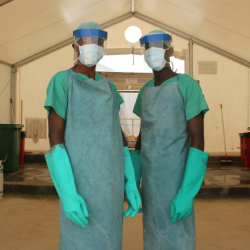
The 2014 outbreak of Ebola virus disease (EVD) in West Africa had an R0 of between 1.71 and 2.02 (varying by country) according to a paper published in October by the World Health Organisation’s (WHO) Ebola Response Team. Christl Donnelly, professor of statistical epidemiology at Imperial College London, was part of that team. She was at Oxford University last week to deliver the Florence Nightingale lecture, during which she discussed her work on Ebola, and her career more broadly.
In her talk, Donnelly explained how important it was during any disease outbreak to implement control methods to bring the R0 number below 1. This can be achieved in many different ways: by treating patients in isolation wards, for instance, or by implementing vaccination programmes, or by adhering to basic hygiene protocols.
Without control methods, the consequences can be dire. That first paper published by the WHO response team estimated that, with no changes to control efforts, the number of Ebola infections would increase from 4,507 confirmed and probable cases as of September 2014 to more than 20,000 cases by November 2014.
'We concluded that without drastic improvements in control measures, the numbers of cases of and deaths from EVD were expected to continue increasing from hundreds to thousands per week,' Donnelly explained.
The results of this analysis were used by WHO to highlight the need for treatment centres, protective masks, diagnostic capabilities and other measures to slow the spread of the disease. It had the desired effect. A follow-up report, published on the 24 December, showed that the growth in cases had not been as severe as originally predicted and that interventions were starting to have an impact.
As of 15 April 2015, WHO reported total Ebola infections to date of 25,791 (including 8,380 suspected cases) in Guinea, Liberia and Sierra Leone. More than 10,600 people have died of the disease since the outbreak began. Although the previous 21 days had seen 149 new cases of infection, WHO figures suggest that the outbreak is in a downward phase.
The impact of Ebola has been massive and tragic, though Donnelly noted that its effects are not limited only to those it has directly infected or killed. The Ebola outbreak is likely to have indirectly caused many more deaths in West Africa as efforts to tackle the virus disrupted treatment and prevention programmes for other big killers in the region, including measles – which has an historic R0 of 12–18 – and malaria. In March, WHO called for mass vaccination programmes for measles in Ebola-affected areas, as well as the mass distribution of anti-malarial drugs.
For epidemiologists like Donnelly, the fight against killer diseases continues.



